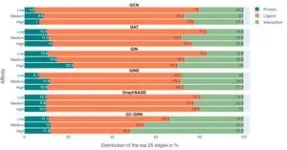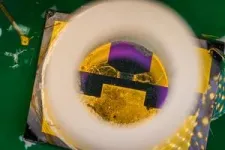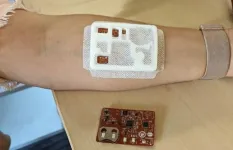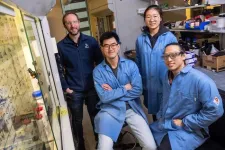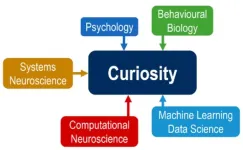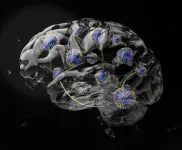(Press-News.org) Artificial intelligence (AI) is on the rise. Until now, AI applications generally have “black box” character: How AI arrives at its results remains hidden. Prof. Dr. Jürgen Bajorath, a cheminformatics scientist at the University of Bonn, and his team have developed a method that reveals how certain AI applications work in pharmaceutical research. The results are unexpected: the AI programs largely remembered known data and hardly learned specific chemical interactions when predicting drug potency. The results have now been published in Nature Machine Intelligence.
Which drug molecule is most effective? Researchers are feverishly searching for efficient active substances to combat diseases. These compounds often dock onto protein, which usually are enzymes or receptors that trigger a specific chain of physiological actions. In some cases, certain molecules are also intended to block undesirable reactions in the body - such as an excessive inflammatory response. Given the abundance of available chemical compounds, at a first glance this research is like searching for a needle in a haystack. Drug discovery therefore attempts to use scientific models to predict which molecules will best dock to the respective target protein and bind strongly. These potential drug candidates are then investigated in more detail in experimental studies.
Since the advance of AI, drug discovery research has also been increasingly using machine learning applications. As one "Graph neural networks" (GNNs) provide one of several opportunities for such applications. They are adapted to predict, for example, how strongly a certain molecule binds to a target protein. To this end, GNN models are trained with graphs that represent complexes formed between proteins and chemical compounds (ligands). Graphs generally consist of nodes representing objects and edges representing relationship between nodes. In graph representations of protein-ligand complexes, edges connect only protein or ligand nodes, representing their structures, respectively, or protein and ligand nodes, representing specific protein-ligand interactions.
"How GNNs arrive at their predictions is like a black box we can't glimpse into," says Prof. Dr. Jürgen Bajorath. The chemoinformatics researcher from the LIMES Institute at the University of Bonn, the Bonn-Aachen International Center for Information Technology (B-IT) and the Lamarr Institute for Machine Learning and Artificial Intelligence in Bonn, together with colleagues from Sapienza University in Rome, has analyzed in detail whether graph neural networks actually learn protein-ligand interactions to predict how strongly an active substance binds to a target protein.
How do the AI applications work?
The researchers analyzed a total of six different GNN architectures using their specially developed "EdgeSHAPer" method and a conceptually different methodology for comparison. These computer programs "screen" whether the GNNs learn the most important interactions between a compound and a protein and thereby predict the potency of the ligand, as intended and anticipated by researchers - or whether AI arrives at the predictions in other ways. "The GNNs are very dependent on the data they are trained with," says the first author of the study, PhD candidate Andrea Mastropietro from Sapienza University in Rome, who conducted a part of his doctoral research in Prof. Bajorath's group in Bonn.
The scientists trained the six GNNs with graphs extracted from structures of protein-ligand complexes, for which the mode of action and binding strength of the compounds to their target proteins was already known from experiments. The trained GNNs were then tested on other complexes. The subsequent EdgeSHAPer analysis then made it possible to understand how the GNNs generated apparently promising predictions.
"If the GNNs do what they are expected to, they need to learn the interactions between the compound and target protein and the predictions should be determined by prioritizing specific interactions," explains Prof. Bajorath. According to the research team's analyses, however, the six GNNs essentially failed to do so. Most GNNs only learned a few protein-drug interactions and mainly focused on the ligands. Bajorath: "To predict the binding strength of a molecule to a target protein, the models mainly 'remembered' chemically similar molecules that they encountered during training and their binding data, regardless of the target protein. These learned chemical similarities then essentially determined the predictions."
According to the scientists, this is largely reminiscent of the "Clever Hans effect". This effect refers to a horse that could apparently count. How often Hans tapped his hoof was supposed to indicate the result of a calculation. As it turned out later, however, the horse was not able to calculate at all, but deduced expected results from nuances in the facial expressions and gestures of his companion.
What do these findings mean for drug discovery research? "It is generally not tenable that GNNs learn chemical interactions between active substances and proteins," says the cheminformatics scientist. Their predictions are largely overrated because forecasts of equivalent quality can be made using chemical knowledge and simpler methods. However, the research also offers opportunities of AI. Two of the GNN examined models displayed a clear tendency to learn more interactions when the potency of test compounds increased. "It's worth taking a closer look here," says Bajorath. Perhaps these GNNs could be further improved in the desired direction through modified representations and training techniques. However, the assumption that physical quantities can be learned on the basis of molecular graphs should generally be treated with caution. "AI is not black magic," says Bajorath.
Even more light into the darkness of AI
In fact, he sees the previous open access publication of EdgeSHAPer and other specially developed analysis tools as promising approaches to shed light on the black box of AI models. His team's approach currently focuses on GNNs and new "chemical language models". "The development of methods for explaining predictions of complex models is an important area of AI research. There are also approaches for other network architectures such as language models that help to better understand how machine learning arrives at its results," says Bajorath. He expects that exciting things will soon also happen in the field of "Explainable AI" at the Lamarr Institute, where he is a PI and Chair of AI in the Life Sciences.
Publication: Andrea Mastropietro, Giuseppe Pasculli, and Jürgen Bajorath: Learning characteristics of graph neural networks predicting protein-ligand affinities, Nature Machine Intelligence, DOI: 10.1038/s42256-023-00756-9, Internet: https://www.nature.com/articles/s42256-023-00756-9
Contact for the media:
Prof. Dr. Jürgen Bajorath
LIMES Institute of the University of Bonn
Bonn-Aachen International Center for Information Technology (B-IT)
Lamarr Institute for Machine Learning and Artificial Intelligence
Phone +49 (0)228 7369103 (Secretariat)
E-mail: bajorath@bit.uni-bonn.de
END
Artificial intelligence: Unexpected results
Researchers at the University of Bonn take a look behind the scenes of machine learning in drug research
2023-11-13
ELSE PRESS RELEASES FROM THIS DATE:
Migrant couples have better relationships when they can balance old and new cultures
2023-11-13
BINGHAMTON, N.Y. -- Migrant couples who can effectively balance the culture of their homeland while adapting to the dominant culture of their new home are more likely to have a better relationship, according to newly published research from psychologists at Binghamton University, State University of New York.
“When immigrants venture into a new country, they embark on a journey of blending cultures while keeping their roots alive,“ said Binghamton University PhD candidate Quinn Hendershot. “There has been limited research on how their ability to adjust to a new culture while embracing the cultures of their homeland can affect the relationship.”
Hendershot ...
Worcester Polytechnic Institute researcher leads project to develop oxygen sensor for premature infants of color
2023-11-13
– The National Institutes of Health (NIH) has awarded $1.1 million to a team led by Worcester Polytechnic Institute (WPI) researcher Ulkuhan Guler to develop a first-of-its-kind wearable sensor for premature infants that will address racial bias in healthcare by monitoring oxygen levels two different ways and correcting the measurements to account for variations in skin color.
The four-year project will create a convenient, affordable, noninvasive sensor about the size of a bandage that will enable infants at risk of lung disease to leave hospitals sooner and be accurately monitored at home, said Guler, an associate professor in the Department ...
Fluorine catch-and-attach process could boost drug efficiency
2023-11-13
HOUSTON – (Nov.13, 2023) – When it comes to chemical reactions, fluorine has a reputation as a ‘magic bullet atom’ for its ability to increase a drug’s absorption and prolong its lifetime. However, traditional methods of adding it to compounds entail expensive materials and can be difficult to pull off.
Rice University scientists developed a reliable and cost-effective process of adding fluorine to molecules for increased pharmaceutical drug efficiency using an iron and ...
New assay could revolutionize detection and treatment of acute myeloid leukemia
2023-11-13
Philadelphia, November 13, 2023 – A novel assay that detects a unique molecular marker in patients with acute myeloid leukemia (AML) may revolutionize the way this disease is detected and treated according to a new report in The Journal of Molecular Diagnostics published by Elsevier. This assay may improve detection of AML driven by KMT2A gene fusions and may affect treatment decision-making, assessing response to therapy, and long-term surveillance.
AML is a rare, aggressive blood cancer diagnosed in around 120,000 individuals worldwide each year. Detecting residual disease during treatment is essential for determining prognosis and ...
Curiosity and pure maths
2023-11-13
The German Research Foundation (DFG) will be funding a new Research Training Group (RTG) at the University of Göttingen from next year. The RTG "Curiosity" is based at the Faculty of Biology and Psychology. Funding is expected to total around 7.8 million euros over the following five years. In addition, the DFG has extended the funding for the RTG "Fourier Analysis and Spectral Theory" at the Faculty of Mathematics and Computer Science by five years. The award for this RTG totals around 4.5 million euros over the extended funding period.
Curiosity is broadly defined ...
Limited positive childhood experiences linked to higher binge-eating risk in college
2023-11-13
New findings from the University of Houston Department of Health and Human Performance reveal a significant association between a lower number of positive childhood experiences and a higher prevalence of binge-eating disorder characteristics, as well as lower scores for intuitive eating.
Binge eating, which includes consuming a substantial amount of food within a brief timeframe and experiencing a loss of control, is linked to adverse weight-related health effects and challenges in mental well-being. Intuitive eating, ...
Rensselaer Polytechnic Institute Nanotechnology expert Nikhil Koratkar named American Physical Society Fellow
2023-11-13
Nikhil Koratkar, Ph.D., John A. Clark and Edward T. Crossan Professor of Engineering at Rensselaer Polytechnic Institute, has been named a fellow of the American Physical Society (APS). Koratkar was recognized for his pioneering contributions to the field of nanoscale science and technology and the use of nanoscale materials in composites and energy storage devices. Each year, no more than 0.05% of the society membership is recognized by their peers for election to the status of fellow of the American Physical Society.
The APS Fellowship Program recognizes members ...
Children’s National Hospital selected as member of ARPA-H Investor Catalyst Hub spoke network
2023-11-13
WASHINGTON, D.C. (Nov. 13, 2023) – Children’s National Hospital was selected as a spoke for the Investor Catalyst Hub, a regional hub of ARPANET-H, a nationwide health innovation network launched by the Advanced Research Projects Agency for Health (ARPA-H).
The Investor Catalyst Hub seeks to accelerate the commercialization of groundbreaking and accessible biomedical solutions. It uses an innovative hub-and-spoke model designed to reach a wide range of nonprofit organizations and Minority-Serving Institutions, with the aim of delivering scalable healthcare outcomes for all Americans.
“The needs of ...
Antiviral treatment is largely underused in children with influenza, study findings show
2023-11-13
Despite national medical guidelines supporting the use of antiviral medications in young children diagnosed with influenza, a new study reports an underuse of the treatment.
“Trends in Outpatient Influenza Antiviral Use Among Children and Adolescents in the United States” was published in Pediatrics, a peer-reviewed journal of the American Academy of Pediatrics.
“Antiviral treatment, when used early, improves health outcomes with influenza,” said lead author and principal investigator James Antoon, MD, PhD, MPH, assistant professor of Pediatrics and Hospital ...
Twisted magnets make brain-inspired computing more adaptable
2023-11-13
A form of brain-inspired computing that exploits the intrinsic physical properties of a material to dramatically reduce energy use is now a step closer to reality, thanks to a new study led by UCL and Imperial College London researchers.
In the new study, published in the journal Nature Materials, an international team of researchers used chiral (twisted) magnets as their computational medium and found that, by applying an external magnetic field and changing temperature, the physical properties of these materials could be adapted to suit different machine-learning tasks.
Such an approach, known as physical reservoir ...
LAST 30 PRESS RELEASES:
Researchers use robotics to find potential new antibiotic among hundreds of metal complexes
Gut bacteria changes at the earliest stages of inflammatory bowel disease
Scientists develop new way to “listen in” on the brain’s hidden language
Brain research: “Pulse generators” grow and shrink as memories are formed
For teens, any cannabis use may have impact on emotional health, academic performance
School meals could unlock major gains for human and planetary health
Menopause hormone therapy does not appear to impact dementia risk
Signature patterns of brain activity may help predict recovery from traumatic brain injury
Dresden study uncovers new key mechanism in cancer cells
New species are now being discovered faster than ever before, study suggests
Cannabis-based products show limited short-term benefit for chronic pain, with increased risk of adverse effects
Cannabis products with more THC slightly reduce pain but cause more side effects
Clearing the brain of aging cells could aid epilepsy and reduce seizures
Brain injuries linked with potential risk of suicide, new study finds
New technique lights up where drugs go in the body, cell by cell
New study finds movement of fishing fleets can reveal shifts in marine ecosystems
Embargoed: New evidence points to potential treatment for vascular dementia
Study uncovers disrupted brain balance in alcohol dependence
Working in groups can help Republicans and Democrats agree on controversial content moderation online
Structural findings reveal how distinct GPCR ligands create different levels of activation
Anything-goes “anyons” may be at the root of surprising quantum experiments
UC review: Maximizing workplace opportunity for veterans
From generation to complex control: Metasurfaces make perfect vortex beams "within reach"
Thin-film lithium niobate-based detector: recent advances and perspectives
Exploring why some people may tend to persistently make bad choices
How cells balance their protein levels
Nirsevimab vs RSVpreF vaccine for RSV–related hospitalization in newborns
Effectiveness and impact of maternal RSV immunization and nirsevimab on medically attended RSV in US children
AI gives scientists a boost, but at the cost of too many mediocre papers
Next-generation vision model maps tree growth at sub-meter precision
[Press-News.org] Artificial intelligence: Unexpected resultsResearchers at the University of Bonn take a look behind the scenes of machine learning in drug research

